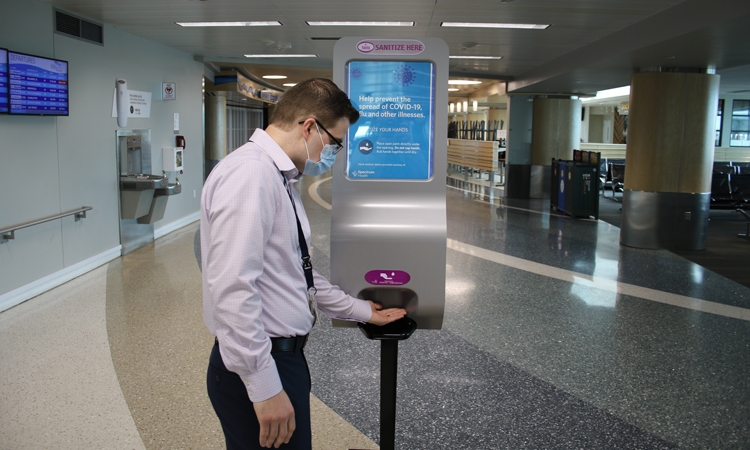Fly Safe, Fly Ford: Steps a Michigan airport has taken to battle COVID-19
- Like
- Digg
- Del
- Tumblr
- VKontakte
- Buffer
- Love This
- Odnoklassniki
- Meneame
- Blogger
- Amazon
- Yahoo Mail
- Gmail
- AOL
- Newsvine
- HackerNews
- Evernote
- MySpace
- Mail.ru
- Viadeo
- Line
- Comments
- Yummly
- SMS
- Viber
- Telegram
- Subscribe
- Skype
- Facebook Messenger
- Kakao
- LiveJournal
- Yammer
- Edgar
- Fintel
- Mix
- Instapaper
- Copy Link
Posted: 17 June 2020 | Tory Richardson - Gerald R. Ford International Airport | No comments yet
Tory Richardson, President and CEO of Gerald R. Ford Airport, discusses the impact of COVID-19 on the airport and how its new “Fly Safe, Fly Ford” campaign will work to restore passenger confidence.


Credit: Gerald R. Ford International Airport
To effectively battle COVID-19, the team at Gerald R. Ford International Airport (GRR) is relying on a combination of high-tech solutions and high-intensity cleaning to regain the confidence of business and leisure travellers.
Like most American airports, we were surprised by the velocity of the impact that coronavirus had on air travel”
Like most American airports, we were surprised by the velocity of the impact that coronavirus had on air travel. We began March 2020 with 29 consecutive months of passenger growth, setting and then breaking record after record as we prepared to launch a $90 million expansion of our main concourse to meet this stellar demand. When Gretchen Whitmer, the Governor of Michigan, signed her ‘Stay Home, Stay Safe’ order on 23 March 2020, we noticed a precipitous fall of 96 per cent in passenger volume.
Overnight, Gerald R. Ford Airport witnessed a drop from 7,000 daily passengers (during what is normally a peak travel time) to fewer than 200. The airport and our travel partners felt this impact deeply, as all retail and restaurants closed, our parking garage remained empty and rental cars sat idle.
Responding to COVID-19
Our internal COVID Response Team met daily during this time to monitor and respond to the pandemic”
With the full support of our Board of Directors, our internal COVID Response Team met daily during this time to monitor and respond to the pandemic. During April 2020, Michigan ranked third in the United States with the total number of COVID-19-related deaths, falling behind only New York and New Jersey. Gerald R. Ford Airport invested significant time and resources to protect the health and safety of everyone who passed through our terminal and into – as well as beyond – West Michigan.
During this time, we worked closely with our travel partners to take steps to flatten the curve. We drew on a number of trusted healthcare sources for our information – including the Centers for Disease Control (CDC), our state health department and our county health department. From hiring a specialist to sanitise and disinfect, to investing in education programmes for our team, tenants and travellers, we adopted all the best practices recommended for facilities like ours.
As we turn the corner into May 2020, the numbers of infections and deaths in our state are beginning to decrease. Michigan has slowly begun loosening ‘stay home’ restrictions as we work to safely return to normal. Manufacturing – the true engine of our economy – is again up and running at full force. At the time of writing, retailers, dine-in services at restaurants, vacation rentals and limited group gatherings have also been allowed.
“Fly Safe, Fly Ford”
Slowly but surely, Gerald R. Ford Airport is seeing passenger numbers rebound. Our team cheered when we passed the milestone of 600 passengers a day – then, a mere nine weeks later, cheered again when that doubled. To ensure that we are prepared for recovery and growth, we have launched the initial stages of our “Fly Safe, Fly Ford” campaign, which combines effective sanitation, enhanced physical protocols and mindful physical distancing with proactive communications to reinforce the new safeguards that we have put in place.
As a regional hub, our relatively smaller size plays to our advantage at this juncture”
As a regional hub, our relatively smaller size plays to our advantage at this juncture. With less physical space to maintain and staff already focused on the guest experience, we have been able to implement tactics to keep our passengers, crew and team safe fairly easily. To solidify this in the eyes of business and leisure travels, we have taken a number of steps, including:
- Placement of hand sanitiser stations throughout the terminal, pre- and post-Transportation Security Administration (TSA) screening
- Installation of custom plexiglass at all interaction points, including ticket counters, rental car facilities, etc.
- Offering personal protective equipment (PPE) to guests in concession areas and through vending machines
- Use of visual cues to reinforce physical distancing throughout the airport through floor clings, stanchion toppers, wall decals and computer monitors
- Placement of signage throughout the terminal – overhead, wall-mounted, door-placed – reminding guests about ways to limit the spread of COVID-19
- Reliance on continuous cleaning protocols to disinfect and sanitise high-traffic areas for our employees, tenants and guests, including bathrooms, airline kiosks, TSA bins, etc.
- Installation of energy-efficient HVAC systems that improve indoor air quality and temperature comfort
- Encouragement of all team members and guests to wear facial coverings.
Facility disinfection and sanitisation
We are particularly pleased to serve as a test site for an autonomous disinfecting robotic vehicle – or LaaD – developed by Pratt Miller, a Michigan company focused on mobility. A first-of-its-kind technology deployed in the United States, LaaD is a connected, electric, autonomous disinfecting robot that will dispense Food and Drug Administration (FDA) approved disinfecting materials through a multi-head electrostatic sprayer array.
The electrostatic technology sprays disinfectant into the air and adheres to surfaces for maximum virus protection, while the autonomous platform monitors and guarantees coverage through the use of sensors and data analysis. LaaD will ‘roam’ the airport, disinfecting more effectively so that Gerald R. Ford Airport can maintain the highest standards of cleanliness in high-traffic areas. Pratt Miller recently received a technology activation grant from PlanetM, Michigan’s mobility initiative, as one of five companies working to address mobility challenges presented by COVID-19.
Airports of all sizes are working to address mobility challenges presented by this once-in-a-century situation”
That can equally be said of Gerald R. Ford Airport and our counterparts across the state, around the country and throughout the world. Airports of all sizes are working to address mobility challenges presented by this once-in-a-century situation. We must do so by drawing on our creativity, innovation and amazing teams to identify and develop solutions that restore the confidence of the travelling public and bring them back through our doors – and into the skies.
What the future holds for Gerald R. Ford Airport
We recognise the critical importance of restoring confidence in the flying public”
In the coming weeks, we will unveil the public face of our “Fly Safe. Fly Ford.” campaign. We recognise the critical importance of restoring confidence in the flying public to ensure that they understand the many safety precautions implemented on their behalf. Our airline partners have already begun their messaging, which, when combined with competitive airfares, will provide a critical jumpstart to recovery. Large U.S. hubs – such as Las Vegas and Los Angeles – have developed slogans and collateral to engage and inform travellers, but Gerald R. Ford Airport may be the first, and perhaps only, small hub to undertake such a campaign.
“Fly Safe. Fly Ford.” plays to the strengths inherent in our smaller size. Following a time when we have all been required to stay home in order to stay safe, many are longing to travel but, understandably, have concerns. While passengers at Gerald R. Ford Airport still have access to world-class amenities, we typically experience smaller crowds – providing opportunities for greater physical distancing and a more personalised experience. Supported by a team that has a deep passion for the guest experience and a strong commitment to safety, passengers will be able to resume their travels knowing that they are in good hands.
Our hope is to restore confidence in our community as we connect them with the world beyond West Michigan”
We have begun rolling out messaging to the travelling public through a combination of in-terminal and external communications that lean on traditional and social media-based advertising. Our hope is to restore confidence in our community as we connect them with the world beyond West Michigan. We look forward to setting new records – safely – and then breaking them in the years ahead.
Biography
Tory Richardson is the President and Chief Executive Officer of Gerald R. Ford International Airport, where he joined in September 2019, bringing with him more than two decades of aviation experience. Richardson is the current chair of the American Association of Airport Executives (AAAE), where he previously served on the policy review committee. Richardson earned a Bachelor of Science degree in Aviation Management from the University of Dubuque.
Related topics
Airport crisis management, COVID-19, New technologies, Passenger experience and seamless travel, Safety, Terminal operations
Related airports
Related organisations
Centers for Disease Control and Prevention (CDC), Food and Drug Administration (FDA), Pratt Miller, Transportation Security Administration (TSA)


















